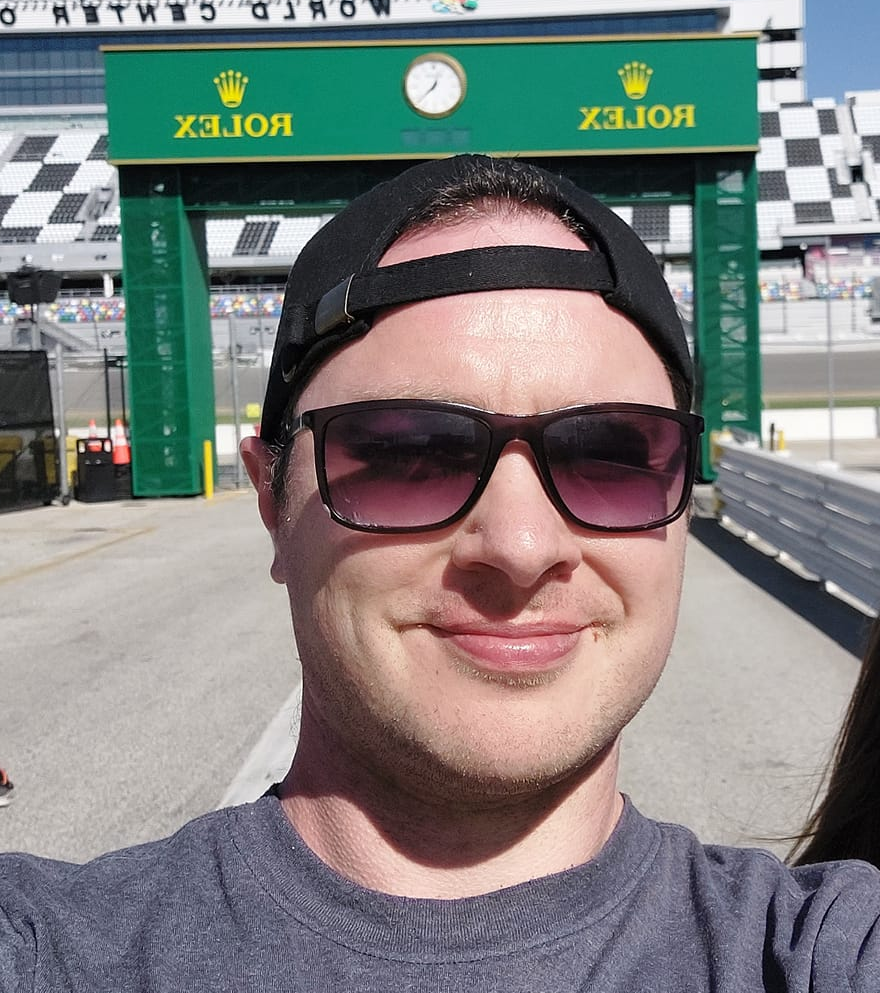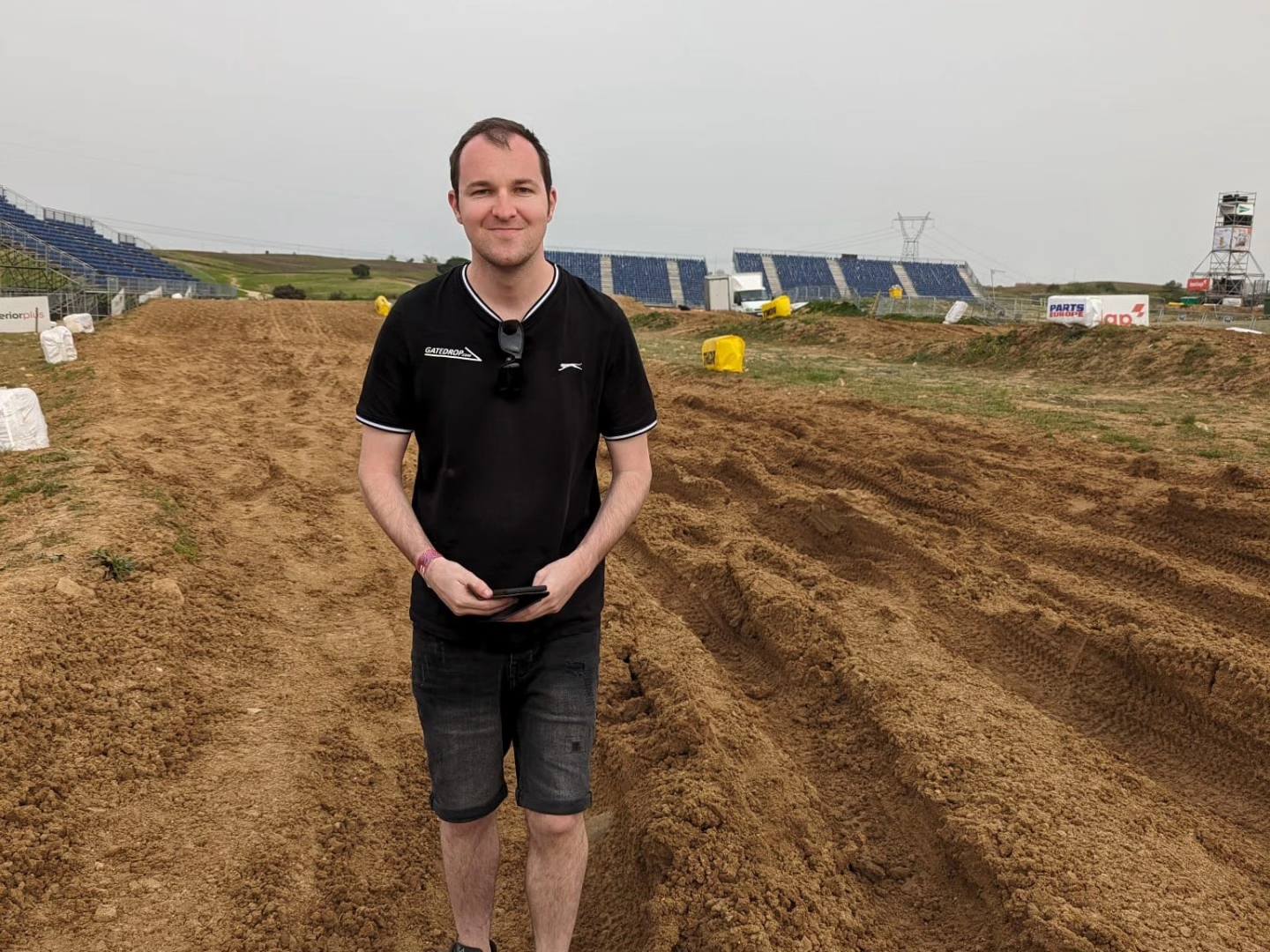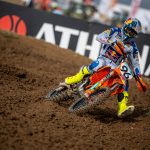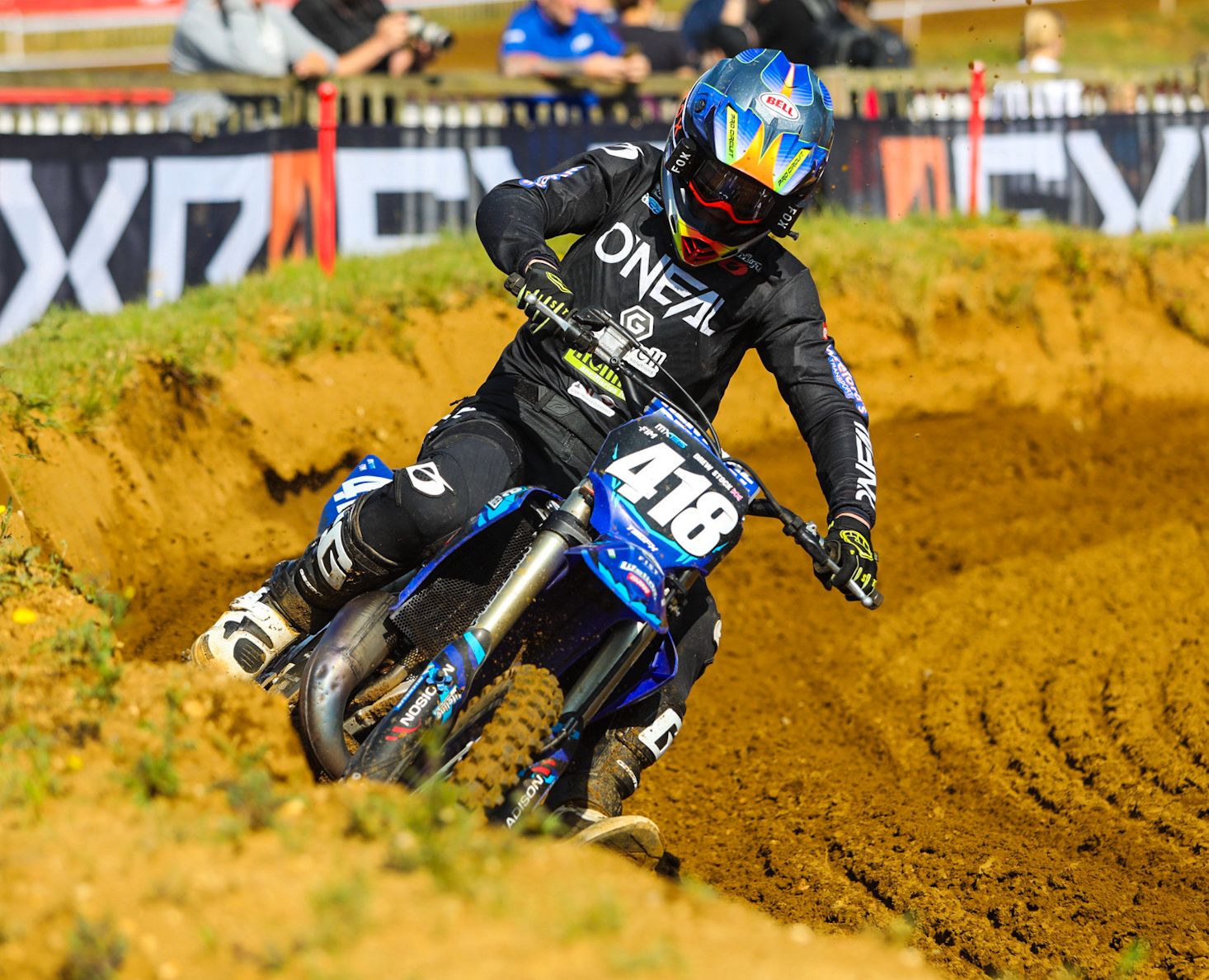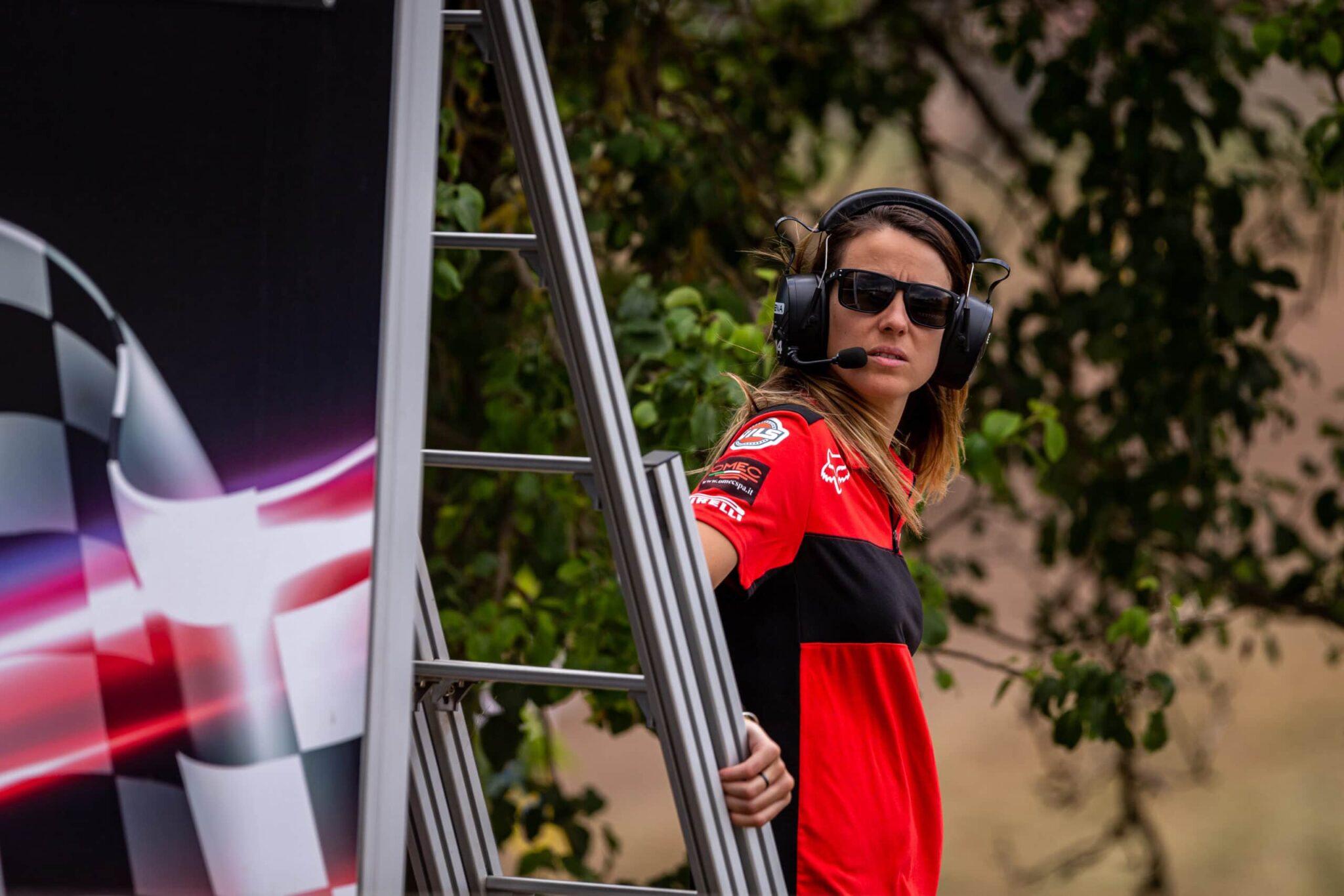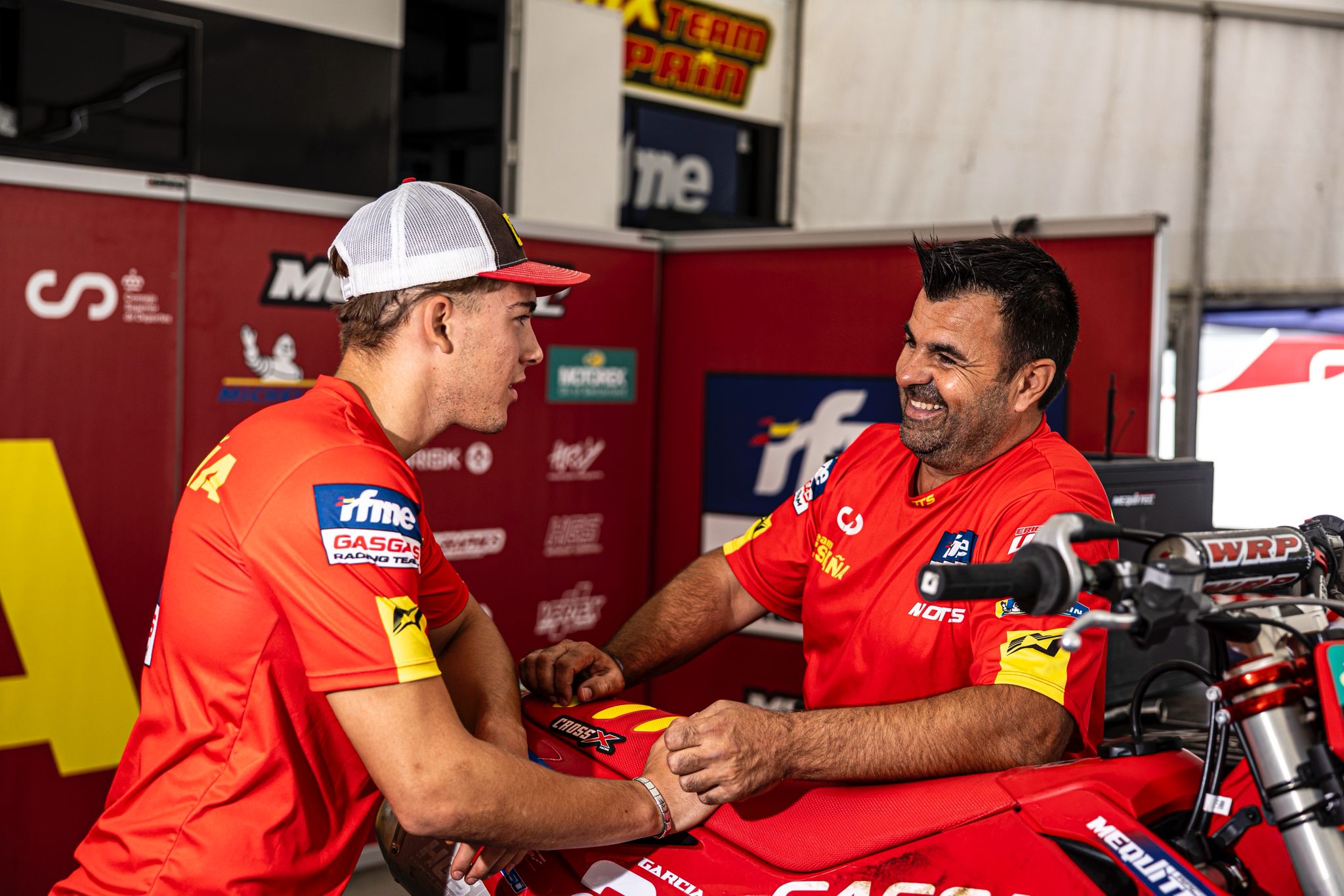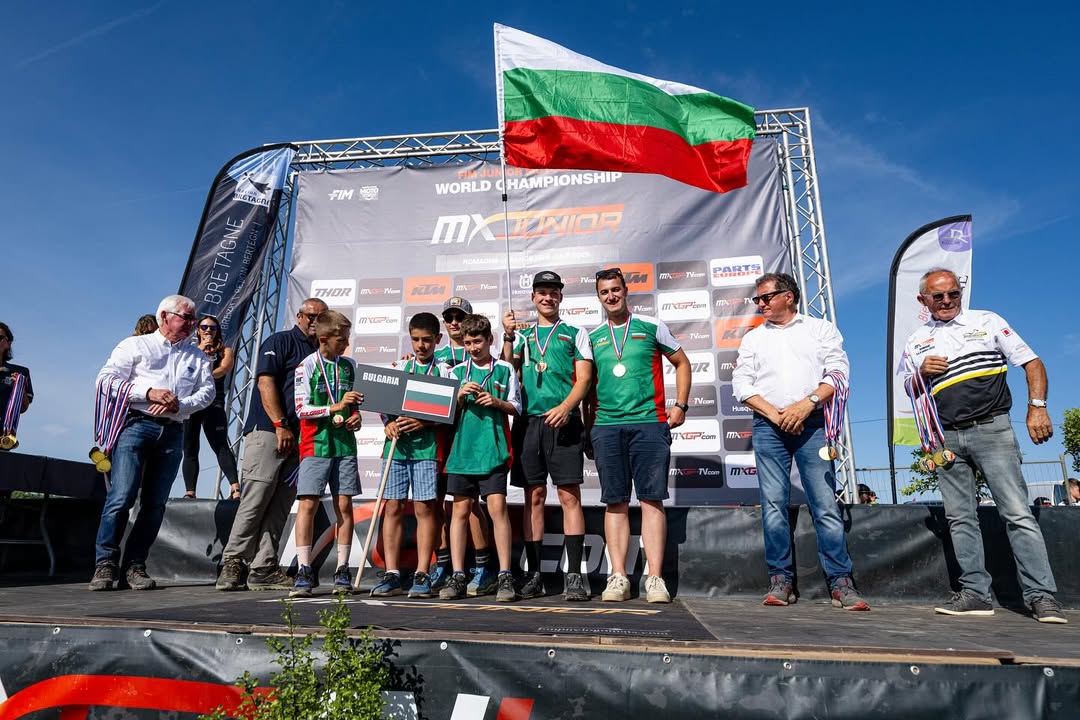After a season outside the GP paddock, Tom Guyon has signed with Riley Racing for the 2025 season to contest the MX2 World Championship in what will be his final year in the class due to the U23 age rule. This year, Guyon focused on the French Elite but also travelled to America to contest two rounds of the AMA Nationals which was a great experience.
Kevin Frelaud from DailyMotocross.fr recently caught up with Guyon and was kind enough to send us the interview which you can read below…
Tom, first of all, how are you doing since that vertebrae injury?
Guyon: Pretty good. I had a scan last week, and it’s going really well. Everything’s recovering properly, I’ve got no displacement and it’s almost 100% consolidated, so I’ll be able to get back on the bike around November the 8th. I can’t wait. I was “lucky” in my misfortune, because nothing moved. I didn’t need an operation, and the surgeon told me that I wasn’t at risk of losing sensation or becoming a paraplegic because of the fracture. That was reassuring, because when I went into hospital, they scared me to death, telling me that I really mustn’t move. In the beginning, the neck brace was a real pain because I had to wear it 24/24, be washed by the nurses, stay in a medical bed… It’s never very nice. But I had to do things properly to avoid any after-effects.
Have you been able to get into physical training yet, or is that not on the agenda?
Guyon: Yes, I’m back at it now. I ride my road bike and work out. I was able to get back into it after a month or so; I still had my neck brace on at the time. I did more weight training at first, though, because doing cardio with a brace is very complicated. You don’t realize it, but it keeps you warm and it’s very uncomfortable. I was able to get back into physical training fairly early, so physically, I won’t be behind in my preparations for 2025. It’s a really good thing because I’ll be able to do a real winter; I’ve been missing my bootcamp for several years now. I’ll be lucky enough to be able to have a real off-season and do some constructive preparation.
In 2024, your program in France was designed to get you back on track. Your primary objective was to return to the World Championship afterwards. That’s now a reality, since you’ve got a ride for 2025. Do you think you’ve succeeded in getting back on track this year?
Guyon: Actually, the season hasn’t been that bad. I’ve had a few problems, particularly with my forearms. Of course, I also got back on the bike very late in the off-season because of my knee, but in the end, the main aim was to get back on track and get a GP ride, so we’ve achieved our objective.
It’s already a good thing, to be able to look forward to a Grand Prix season next year. I’ve got my rhythm back, I was on pole in the US, I was up front in the French championship and there was still a good level in MX2. I’m happy, but I know I’ve still got a lot of work to do next year. They are all very fast at the GP’s, but to be honest, it’s still been a productive season.
When you announced your presence in the Elite MX2 class, we inevitably think that you’re aiming for podiums, victories and a title. You missed out on one round, and that was it, but apart from that, did you expect to line up against this type of competition in France this season?
Guyon: No, to be honest, there was some very fast riders this season. There were the two Mathys (Boisrame) / Mathis (Valin) who rode very hard. We saw Valin become European champion. He was riding with us in France and I think he had the speed to be in the top five in the MX2 GP class. That set a very good pace in the French championship, so if you look at it, the level wasn’t bad at all and I think I still put in some good performances. Of course, I would have liked to have done a bit better, but that’s the way it is.
Valentin (Teillet) tried to do as much as he could for me, without really doing any winter training. We discussed it together and we’re satisfied with the season. Our aim was to be back in GP, and that’s been achieved. Valentin really enabled me to rediscover the pleasure of riding a bike, and to rediscover my technique. That was also very important for me.
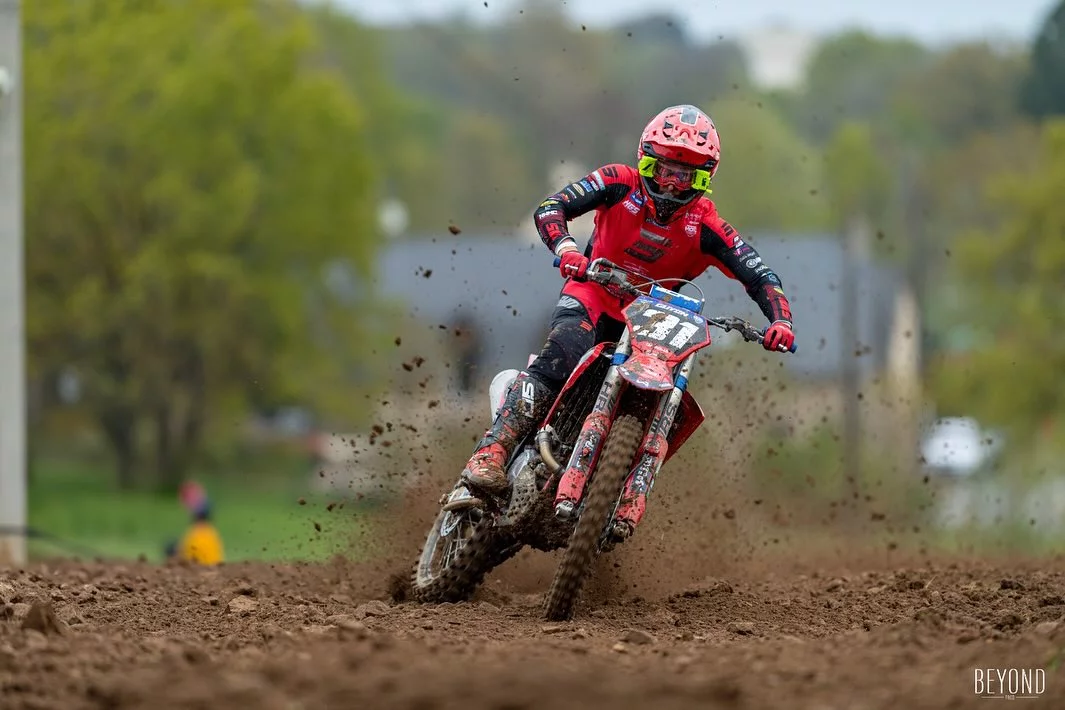
When you were with Fantic, you were pretty much on your own. You joined Valentin’s (Teillet) team this season. It’s a small structure, but he seems to be very involved as a coach; he’s obviously a very hands-on guy. For you, going from Fantic to 737 Performance GasGas Team must be like night and day?
Guyon: It’s true that at Fantic, we were really on our own. Honestly, it wasn’t the best experience I’ve had in my riding years, especially as the bike unfortunately didn’t perform as well as we’d hoped. That was the big negative point that unfortunately cost me the season, which is a real shame, because I really believed in the project.
With Valentin, it’s a much smaller structure, but more family oriented. He’s tried to do his utmost for me, and I’ve seen all the efforts he’s made, which is really satisfying and motivating. Valentin has quite a few projects on the side, so I knew it wasn’t always easy for him, but I’m honestly happy with what he’s done for me.
Valentin has given me a lot, he’s got a good eye and he’s able to pass things on to me, because I have complete confidence in what he tells me. Frankly, I’ve really enjoyed working with Valentin and he’s someone I can really listen to, which is another of the reasons why I chose to sign with him this year. Working on those little technical points and finding that motivation again is what I was looking for too.
With your past and present experiences, is having a coach who works well with you one of the most important part in your program?
Guyon: It’s very important. But I’ll speak from my own point of view, because we’re all different, but for me, to perform well in GP’s, you need a really solid team and you need a whole range of things.
If the bike isn’t suited to that level of racing and the engine doesn’t work, it’s hard to perform, because today’s competition is increasingly high. The coach also plays a role; the whole environment has to be healthy, and the team has to be motivated around you.
To ride in the French championship, it’s a bit different. You can have a structure that’s a bit more family-oriented, as we did this year with Valentin, but to ride in MXGP you honestly have to leave nothing to chance, and I think that everything plays a very important role, whether it’s the bike, the trainer, the manager, the physical coach and the rider too, of course. The rider has to feel good within the team, to be able to ride at GP level. It takes a combination of things to make things work properly.
This year, we saw you wildcarding in the MX2 class during Saint Jean d’Angely Grand Prix. During the timed practice session, you had a great time. Can we go back over what happened that day?
Guyon: It was a very short GP appearance. It’s a shame and frustrating, because it’s my club and it was important to me to ride well. I got off to a pretty good start in practice, it was going well and I was comfortable with the track. In fact, during practice, you do a first lap to get a feel for the track, before trying to set a laptime.
During free practice, I was jumping the Pastrana leap, so I figured I’d be able to do it too during time practice. They’d redone the landing and it looked fine. The problem was that they took the dirt from the bottom of the landing and put it back on the top. And on a jump like that, it was way too soft. The impact is so hard when you land that you need a concrete like landing not to be surprised. We saw Thibault crash, and Vlaanderen got a near miss in the same spot. It was a bit dangerous what the Infront teams did there, because it wasn’t the club that managed the track. I launched myself, jumped, crashed at the landing and from there, black hole.
After that, you made a trip to the USA for two rounds. You say that the bike is important in GP racing. I remember chatting with Romain Pape when he was racing in the outdoor 250 class, and he said that if you don’t have a $30,000 bike, it’s not even worth thinking about it, because everyone else is riding rocketships. You picked up a Wildcat Racing bike for these rounds. What was that GasGas worth?
Guyon: Honestly, I agree with Romain’s point of view. I was lucky enough to do two outdoor races with Valentin and it was great. We got a bike from Lorenzo Locurcio’s Wildcat Racing team. The first engine we had was a Supercross engine. The bike worked pretty well, but it wasn’t a rocket either; it did the job. My benchmark is VRT’s KTM from the 2022 season; it was a war machine. I use that bike as a benchmark for knowing whether a bike is great or not. So I knew that the US bike was decent, but it wasn’t crazy either. Especially as standards are different in the US, and bikes in general work really well compared to Europe, there’s a little extra step because the US tracks are really, really soft and ripped deep.
I broke the engine in the second moto at Southwick, straight away. After that, I rode at RedBud with an standard engine. The bike didn’t work in the morning, so I did a slow time in the timed practice and started from a long way back in the motos. With a stock engine, it wasn’t easy.
At Southwick, you took pole position from the B group. That must have been the talk of the town, because the others must have been wondering who Tom Guyon was at the top of the table.
Guyon: That was great. I was a bit surprised too, but Valentin and I had talked about it beforehand. We’d seen that the B group was starting, and we thought there might be something we could do. I seized the opportunity, and some people criticized me [laughs].
What’s the story? In the first few laps, on a brand-new track, did you think bingo and put your foot down from start to finish?
Guyon: In fact, I started way back in the pack during that session because the American riders arrived very early in the pre-grid to start first. I was back in the pack, and it was really tough. I saved one lap, but it wasn’t great because I missed a couple of turns. I knew I’d have to find a bit of space, because I couldn’t take the lines I wanted to. I still did a good lap afterwards, but I’d made a few small mistakes. I told myself I was going to give it my all on the last lap. I done a great lap, went purple in the first 3 sectors but in the last sector a rider crashed in front of me and slowed me down. I still managed to take pole, but I could have done even better. I’d improved my time by a second and a half, so that was great! Then some of the guys said that I’d had a flatter track. Yes, the track was a little flatter than the A group, but I think anyone in my position would have done the same thing. I’m not going to brake for second place… The rules are like that, I’m not the one writting them. I’m doing my job and I’ve been able to start in first position, which is great.
Next time, put the brakes on to keep the social networks happy, okay?
Guyon: Clearly [laughs]. Some guys weren’t particularly happy because – supposedly – it denigrates a guy like Deegan, because some people have the impression that it means that riders are slower in the US compared to Europe … Be aware that they are really fast in the US. I seized the opportunity to set a lap time in those conditions, and I’m not going to stop and take second place and let Deegan take pole.
Where do you stand on the grid, having taken pole? You must have been up against some heavy hitters, with your Wildcat Racing GasGas.
Guyon: I positioned myself on the inside of the doghouse. Deegan was on the other side, and Levi Kitchen on my right. I was pretty confident because I’m a good starter, that’s my strong point. I don’t know where it comes from, but I’ve got a great reaction time and I’ve got a very good feeling for starts. I came off the grid really well in the first moto. We watched the video in slow motion with Valentin, and I was the first one to start and move forward when the grid fell. I slipped a bit in the rut, and when i got into third gear, everyone said ciao and there was nobody left behind me [laughs]. After that, i crashed straight away, and nother 3 times in the moto … It was my fault, I should have channelled myself and climbed back up slowly. The moto was long and I really burnt out physically.
I got off to a pretty good start in the second moto. In fact, there was a red flag at the second start. I’d started 16/17 and was up 9th or 10th on the first lap before the moto was stopped. I’d had a great first lap, I’d lost a lot of energy and, to be honest, I was pretty baked when we started again. I took a real physical toll in that moto, dropped my pace and ended up breaking the engine.
From there, you also went to Red Bud. 22-15, scored points, better round. Is this so called Larocco’s Leap really that impressive on a 250 ?
Guyon: Honestly, it’s quite a jump [laughs]. And then, on TV, it tends to flatten. And because the riders ride really well and really fast, you don’t really realize how rough the track is. The tracks over there are very different from those in Europe, and in the end, the riding has to be different. It’s very soft, you have to attack a lot, and you’re in very long ruts. It’s Motocross, but the riding is very different from Europe. Tom Vialle is a good example. He’s a very fine rider, at least in Europe. Here, you can see that he has to attack a lot more. I had a chance to talk to him about it, and he told me that he really needs to adapt his riding to fit American tracks.
It’s true that in GP racing you get this feeling of seeing a lot of stop-and-go, big variations in speed and much slower corners. In the outdoors, guys keep speed everywhere…
Guyon: That’s it. If you put an American in Europe, he’ll be a bit lost at first, just as a Frenchman will be a bit lost when he goes to the US. It’s really two different worlds. Having had this experience, it’s great, the dream. I’m happy to be able to say that I’ve done this in my life, and I don’t regret a thing. Yes, I would have liked to perform more, and why not have an opportunity there, but that wasn’t the case. But I’m still very happy to be back in the GP paddock next year, and that’s what’s important today.
You signed up to join Riley Racing Kawasaki in 2025. How did that come about?
Guyon: Olaf, the team boss, contacted me shortly after the US to see if I’d be interested in returning to Grand Prix racing? I told him “Why not, now we’ll see under what circumstances, what conditions, etc.”.
In the end, I’d like to say it happened pretty quickly. He explained to me the project of racing with Kawasaki, of having Harry Nolte, a very good engine builder, with Jean-Jacques Luisetti also to help in the team…
These are people with a lot of experience, who know what they’re doing, and I said to myself ‘this could be a good opportunity, we’ve got to seize it’.
So you’re signing up to a great deal, but without testing the bike?
Guyon: I was supposed to test the bike shortly after the Rookie’s Cup, but unfortunately I got injured, so we had to cancel the test. Honestly, it doesn’t scare me that much. A lot of people tell me the KX-F is easy; I’ll make up my own mind when I’m on it, but it can’t be a bad bike. In any case, there’ll be a lot of good, experienced people preparing this Kawasaki. Kawasaki is a winning bike, and I’m looking forward to putting it up front next season.
Do we know how your program will unfold next year? From memory, you lived in Les Sables d’Olonne with VRT, then in Italy with Fantic. Finally, you will get to do an off-season in the north of Belgium/Netherlands for the first time?
Guyon: That’s it. They’re giving me a house next to the team. It’s not too far from Eindhoven. I prefer to be based next to the team, because I’m not particularly a fan of having to do things on my own. I like working with the team, and investing myself fully. The coach will also be based there, with the physical coach, the training mechanic, the race mechanic, etc … Obviously, it will be a little simpler.
We’ve been talking since the emx125 days, and you’ve always said that your thing was the world championship. You must see that it’s getting harder and harder for everyone, teams are closing, some riders are on the sidelines. There must be different programs that allow you to make a living without having to go this route, having the hassle and all the sacrifices that it involves. So, what attracts you so much in this world championship?
Guyon: I don’t ride in GP’s for peanuts either. It’s still a job. I manage to earn my living as a rider. What I have trouble understanding is that I see a lot of riders who pay to ride. That really ruins the business of the sport. Paying to ride, I don’t understand the principle. If one day someone offered me to pay to ride, I would simply refuse because it’s a huge investment, all that to take risks. And if I have to pay, I prefer to do my program on my own, all by myself, to have fewer constraints on that side.
I was offered a pretty good contract to come back to GP. It’s true that this year, I was offered to do a lot of Supercross, in Germany in particular because there’s a lot of money to be made; that’s clear. Now, I think I still have time, I would really like to achieve my goals in Grand Prix because I feel capable of achieving them. I would be really proud to achieve these goals, and I will do my best to get there. I will be as rigorous as possible for my last season in MX2, and we will see what that leads to. For the moment, Riley Racing has offered me something very decent, whether financially speaking or not. I said to myself ” let’s go”. That’s still what drives me.
Doing Supercross in Germany would also be a great opportunity. I think I would like it a lot. But deep down, I tell myself that I can still do something in MX2. I would have time to think about the rest. I ride my dirtbike, I have fun, and I still want to enjoy these moments. You can’t ride dirtbike all your life, but I don’t want to ride and earn nothing; it is impossible.
As an adult, you have things to pay for, projects; you have to be paid your fair value as a rider. You can’t ask for a million euros when you’re not riding at the front; that’s normal. But it’s true that it’s becoming harder and harder when you see the number of teams that are stopping. I consider myself lucky to have found a deal like this, with Riley. That’s why I really want to seize my chance and show what I’m capable of for this last season in MX2. It’s a shame that Infront puts this age limit of 23, I think it’s a bit early but I’m not the one who makes the rules.
Let’s imagine. You have the season of a lifetime next year. You’re riding in the top 10, you’re scoring top 5s. Let’s say you finish the MX2 World Championship season in 7th or 8th place. That would be a very solid season. Given that it would be your last season in MX2, you’ll then be forced to move up to MXGP. Do you think that kind of season would give you opportunities later on? Can you see yourself in the MXGP World Championship?
Guyon: Afterwards, I don’t know if my career will take the direction of the MXGP world championship. On the other hand, the 450 is really a bike that I love. If it can lead to something interesting, why not. I would like to continue racing, because it is really my passion. I live for it. If I can have the season of my life next year, frankly, I’ll sign right away. I don’t know what the future holds, but I will try to put in place what is necessary so that it goes in the best possible way, and that I get the best possible results because I am starting to have a little experience in MX2. You have to work very hard, I am aware of that.
Now, moving up to MXGP the following year, it’s true that it’s a big step because there, we’re really fighting against guys who have a lot of experience. But the guys who have a lot of experience, they’re starting to get a bit older too and eventually, i think they’ll end up giving up their spot at some point [laughs]. It’s true that they’re riding older and older, but you have to stand out, you have to be better. In any case, in motocross, if you’re up front, you always have a ride. That’s not a problem, but indeed, speed is getting higher and higher in MXGP every time. Yes, I can see myself doing MXGP, but we’ll see.
Riding in the US would also be great, but for that, you first have to have a real season in Europe; that’s undeniable. And then, having been there this year, I realized that life over there is hard because you find yourself a bit alone as a Frenchman, and life is very expensive too. If you sign for $30,000 over there, you’re going to waste money riding in the US.
My feeling is that the EMX250 championship has become this transition class that the MX2 world championship was supposed to be at the time. Today, we have two separate classes and you have guys who could have a career in MX2 and who find themselves on the sidelines in MXGP because in any case, the market is completely blocked. The MX2 class is a class in its own right, and no longer an antechamber according to you?
Guyon: I completely agree with you. As you say, it’s a class in its own. The transition category is the Europe 250. Take a Christian Craig for instance, this guy is very good on a 250 but is not exceptional on a 450. Conversely, you have a Clément Desalle. I heard that he had never ridden in 250 because it was not really what he liked the most. There are riders who have a 250 profile, and others a 450 profile. It’s really a shame that they put an age limit in MX2. Removing it, I think that could really revive motocross. We have to stop focusing so much – and at all costs – on MXGP, MXGP, MXGP…
It would give better value to the whole championship, we would have big names in MX2, guys with a lot of experience. They would not necessarily win because the youth evolves and also arrives each season. I think that some teams would also be interested because a young 250 rider costs less than an MXGP rider to ride up front, and it would probably have similar repercussions and publicity for the brand in return.
This is just my opinion, but i think it is a mistake on their part to set this age rule system. MX2 is considered an antechamber to MXGP. The system in the USA is not bad at all, and it would be great to do the same thing in MX2. Say, if you have two titles in MX2, you are obliged to move to the MXGP class the following year, that is interesting. In my opinion, there would be many more riders on the market and behind the grid if they removed this age rule in MX2.

